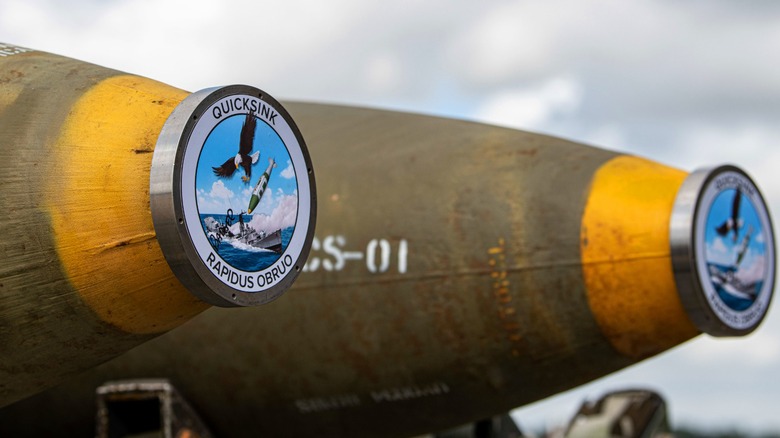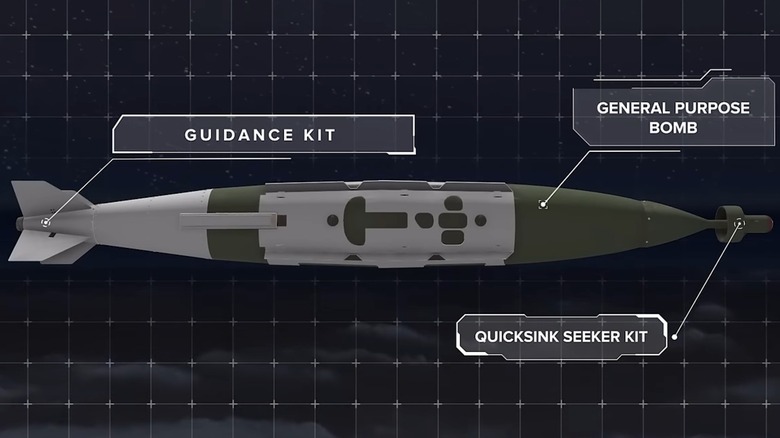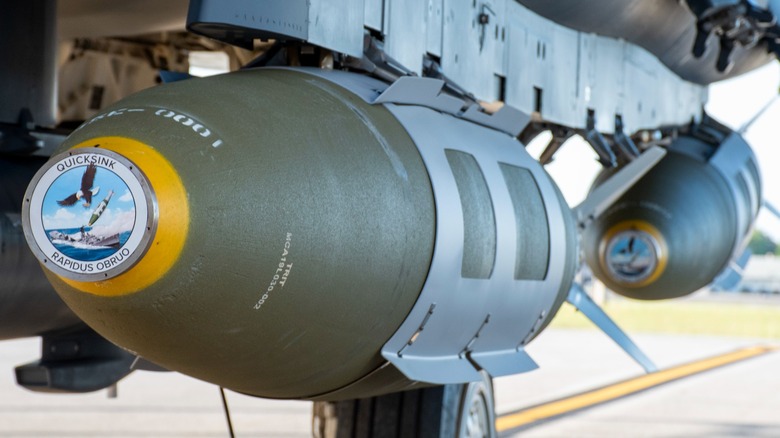The US' Newest Weapon Can Sink Any Ship In Seconds
If there's one thing United States defense contractors are good at, it's dreaming up new ways to use old ordnance effectively. One long-standing example of this is the Joint Direct Attack Munition (JDAM), which is a guidance kit that transforms unguided bombs into precision-guided munitions (PGM). Essentially, they took old 500, 1,000, and 2,000-lb. bombs, upgraded their capabilities with a guidance system, and transformed them into the kinds of weapons that can strike a moving vehicle.
JDAMs have been in service since 1999, and now AFRL has modified the technology once more to transform unguided bombs into relatively inexpensive anti-ship weapons. The company has developed the QUICKSINK, which is a new package designed for old inventory bombs. QUICKSINK includes two main components: a guidance kit installed in the bomb's tail and a QUICKSINK Seeker Kit that's installed on the front. These components work in tandem to guide a previously unguided bomb to strike stationary or moving naval vessels with incredible accuracy and near-unparalleled destruction.
While not intended to replace the U.S. Navy's torpedoes, QUICKSINK bombs will enable the Air Force to rapidly and cheaply strike vessels using fewer resources and potentially greater precision. The first test of the QUICKSINK system came in 2022, and in July 2024, at the annual Rim of the Pacific Exercise (RIMPAC) Sink Exercise (SINKEX), they successfully sank the USS Dubuque (LPD-8) and the USS Tarawa (LHA-1). RIMPAC allowed for the testing of multiple new weapons systems, but QUICKSINK is easily one of the most impressive to come out of the exercise.
The status of QUICKSINK
The QUICKSINK system was developed to fill an anti-ship need by engineering an air-launch weapon that doesn't require many costly components. According to the AFRL website, "QUICKSINK is an answer to the need to quickly neutralize menacing maritime threats over vast areas around the world." Cost is a major consideration, as a single QUICKSINK will run around $50,000 once production surpasses 1,000 units. A 500-lb. GBU-31/B JDAM kit costs around $24,000, making a single QUICKSINK bomb around $74,000. If that seems like a lot of money, it's not when compared to the other options.
The Mk. 48 torpedo is easily the United States' most lethal conventional anti-ship weapon, but they're costly. A Mk. 48 runs American taxpayers around $5.4 million, making it a far more expensive option. Additionally, a submarine like the USS Seawolf exposes its position when it fires a torpedo, so there are other factors at play. Even the least expensive anti-ship missile runs around $1 million or more, making a $74,000 price tag seem almost negligible in comparison. QUICKSINK's price and ease of use make it ideal to fill the gap in anti-ship weapon systems.
Because the QUICKSINK is installed relatively easily on pre-existing ordnance, the transformation is inexpensive and fast. The system's seeker works by identifying a potential target based on length instead of using a database of known ship types. This further reduces cost, and the whole system is plug-and-play, making it even easier to install. Furthermore, QUICKSILVER bombs can be carried by a variety of aircraft, including the F-35A Lightning II.
QUICKSINK
Initially, the QUICKSINK system was installed and tested using 2,000-lb. bombs, but in 2025, a B-2 Spirit Stealth Bomber dropped a 500-lb. version. This is significant because the B-2 has the capability of carrying up to 80 QUICKSINK bombs of that size. Should such a laden aircraft be deployed to a battlespace, it could be used to sink entire fleets of ships, including aircraft carriers, which typically require heavier torpedoes due to their mass. It accomplishes this by detonating next to the target ship's hull just below the waterline.
While tests have proven the technology, there's still more to do before the QUICKSINK is ready for rapid deployment. More testing will be conducted, though the details of what's needed, where, or when it will happen remain classified, as do the details from the June 2025 test. Regarding the size of the ordnance used, according to National Interest, using a 500-lb. bomb is less expensive, and a 2,000-lb. bomb is overkill in most naval scenarios. While the system represents a cheaper alternative to the torpedo, it's not going to replace them.
The goal isn't to do that but rather to supplement and expand the existing anti-ship capabilities of the U.S. military for future potential engagements with countries like China and Russia, and QUICKSILVER seems to do this quite well. As far as when the QUICKSINK might be available for use, that's not something AFRL is discussing with the public. As of mid-2025, QUICKSINK remains a Joint Capability Technology Demonstration (JCTD) and not a fielded weapon system used by the military ... yet.


